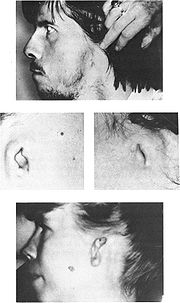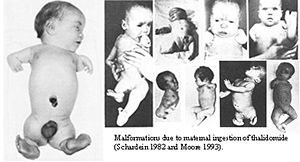
Phocomelia
Encyclopedia



Congenital disorder
A congenital disorder, or congenital disease, is a condition existing at birth and often before birth, or that develops during the first month of life , regardless of causation...
involving the limbs (dysmelia
Dysmelia
Dysmelia is a congenital disorder referring to the limbs. -Types:Dysmelia can refer to*missing limbs: amelia, oligodactyly, congenital amputation...
). Étienne Geoffroy Saint-Hilaire
Étienne Geoffroy Saint-Hilaire
Étienne Geoffroy Saint-Hilaire was a French naturalist who established the principle of "unity of composition". He was a colleague of Jean-Baptiste Lamarck and expanded and defended Lamarck's evolutionary theories...
coined the term in 1836.
Although various numbers of factors can cause phocomelia, the prominent roots come from the drug use of thalidomide
Thalidomide
Thalidomide was introduced as a sedative drug in the late 1950s that was typically used to cure morning sickness. In 1961, it was withdrawn due to teratogenicity and neuropathy. There is now a growing clinical interest in thalidomide, and it is introduced as an immunomodulatory agent used...
and from genetic inheritance. The occurrence of this malformation in an individual results in various abnormalities to the face, limbs, ears, nose, vessels and many other underdevelopments. The best fix for phocomelia is prevention of a pregnant woman taking thalidomide during pregnancy and prosthesis. Although operations can be done to fix the abnormality it is difficult due to the lack of nerves, bones, and other related structures.
Thalidomide
ThalidomideThalidomide
Thalidomide was introduced as a sedative drug in the late 1950s that was typically used to cure morning sickness. In 1961, it was withdrawn due to teratogenicity and neuropathy. There is now a growing clinical interest in thalidomide, and it is introduced as an immunomodulatory agent used...
was released into the market in 1957 in West Germany under the label of Contergan. Primarily prescribed as a sedative or hypnotic, thalidomide also claimed to cure “anxiety, insomnia, gastritis, and tension.” Afterwards it was used to combat against nausea and alleviate morning sickness in pregnant women. Thalidomide became an over the counter drug in Germany around 1960, and could be purchased without a prescription. Shortly after the drug’s selling, in Germany, between 5,000 and 7,000 infants were born with the qualities of phocomelia. Out of these children merely 40% of them survived. Research also proves that although phocomelia was non-existent through the 40’s and 50’s, by time the drug was released in Germany in the 60’s, cases of severe phocomelia amplified; the direct cause was linked to thalidomide. The statistic was given that “50 percent of the mothers with deformed children had taken thalidomide during the first trimester of pregnancy.” Throughout Europe, Australia, and the United States, 10,000 cases were reported of infants with phocomelia; only 50% of the 10,000 survived. Thalidomide became effectively linked to death or severe disabilities among babies. Those subjected to thalidomide while in the womb experienced limb deficiencies in a way that the long limbs either weren’t developed or presented themselves as stumps. Other effects included: deformed eyes, hearts, alimentary, and urinary tracts, along with blindness and deafness.
Genetic inheritance
A genetic disease is inherited by an individual from the genes provided by their mother and father. Depending upon the grouping of these genes for a particular trait, determines whether or not an individual will inherit a certain disease. According to National Organization for Rare Disorders (NORD): when phocomelia is transmitted [in its familial genetic form] it is seen as an autosomal recessive trait and the mutation is linked to chromosome 8Recessive genetic disorders occur when a person receives identical “abnormal genes” from both the father and mother. If a person inherits one normal gene and one gene for the disease, the individual will become a carrier for the disease; however, they normally do not show symptoms. The chance for two carrier parents to both supply the defective gene and produce a child with symptoms is 25 percent with each pregnancy.
During normal cell division, each chromosome is replicated and the original chromosome is attached to the new copy. Although there are several attachment points in a chromosome, the centromere is the major connection point and where the immensity of the work generates. The chromosomes’ connection allows the cells to join together—making sure that the two copies are “lined up together at the center of the dividing cell.” Once the chromosomes are aligned, tiny molecular spindles attach to each copy and then pull away the “original and new copy” as the division continues.
An individual containing phocomelia will have chromosome copies that do not connect at the centromeres, making them unable to line up accordingly. As a result, the cell becomes incapable of division or slow in the process; because of this the newly made cells contain an excessive or reduced amount of chromosomes. In phocomelia the cells cease to develop, or die, preventing proper development of the limbs, eyes, brain, palate, or other structures.
General symptoms
Typically the symptoms of phocomelia syndrome are undeveloped limbs and absent pelvic bones; however, various abnormalities can occur to the limbs and bones. Usually the upper limbs are not fully formed and sections of the “hands and arms may be missing.” Short arm bones, fused fingers, and missing thumbs will often occur. Legs and feet are also affected similarly to that of the arms in hands. Individuals with phocomelia will often experience missing thigh bones, and the hands or feet may be of an unordinary petite size or appear as stumps due to their close “attachment to the body.”According to NORD, individuals carrying phocomelia syndrome will generally show symptoms of growth retardation previous to and after birth. The syndrome can also cause mental deficiencies in infants. Infants born with phocomelia will normally have a petite head with “sparse hair” that may appear “silvery-blonde.” Hemangioma, the abnormal buildup of blood vessels, will possibly develop around the facial area at birth and the eyes may be set widely apart, a condition known as orbital hypertelorism
Hypertelorism
Hypertelorism is an abnormally increased distance between two organs or bodily parts, usually referring to an increased distance between the orbits . In this condition the distance between the inner eye corners as well as the distance between the pupils is greater than normal...
. The pigment of the eyes will be a bluish white. Phocomelia can also cause: an undeveloped nose with slender nostrils, disfigured ears, irregularly petite jaws [also known as micrognathia], and a cleft lip with cleft palate. According to NORD, severe symptoms of phocomelia include:
- A fissure of the skull and a projecting brain known as (encephalocele)
- An accumulation of spinal fluid under the skull also known as hydrocephalus; causing vomiting and migraines
- An abnormally shaped uterus (bicornate)
- Inability to clot blood efficiently due to a low amount of platelets running through the blood
- Malformations in the kidney and heart
- Shortened neck
- Abnormalities in the urethra
Thalidomide syndrome symptoms
When an individual is born with phocomelia due to drugs or pharmaceuticals, it is known as thalidomideThalidomide
Thalidomide was introduced as a sedative drug in the late 1950s that was typically used to cure morning sickness. In 1961, it was withdrawn due to teratogenicity and neuropathy. There is now a growing clinical interest in thalidomide, and it is introduced as an immunomodulatory agent used...
syndrome. The symptoms of thalidomide syndrome are defined by absent or shortened limbs; causing flipper hands and feet. According to Anthony J Perri III, and Sylvia Hsu they can additionally receive:
- Palsy disorder of the face
- Ear and eye abnormalities; resulting in limited/complete loss of hearing or sight
- Gastrointestinal and genitourinary tract disorders
- Ingrown genitalia
- Undeveloped/missing lungs
- Distorted digestive tract, heart, kidney
The infants that were exposed to thalidomide during development phases have a 40% chance of survival. The McMredie-McBride hypothesis explains that the limbs of the infants become malformed as a result to the thalidomide harming the neural tissue—simply because the neural tissue has such a large impact on formation and development of the limbs.
Treatment
Prosthesis is a synthetic alternative for missing limbs, teeth, and various other body parts. Advances in prosthetic limbs have increased greatly during the twentieth century. The use of new materials such as modern plastics, complex procedures and better pigments have created lighter in weight and more realistic looking artificial limbs. With the advancement of myoelectric prosthetic limbs, patients are able to move their limbs without the use of cords or other devices. The myoelectric limbs can detect electric signals from the nervous system and muscles. They were first used on adults, but now they are being fitted to children.Patients that receive a loss of limbs due to phocomelia are typically treated with prosthetics. Infants at the age of 6 months are recommended to have a prosthetic mitten fitted; enabling them to get used to the prosthesis. A hook will be added when the child reaches the age of 2 years. Eventually the patient may receive a myoelectric prosthetic limb. Patients are treated in this way due to the lack of understanding at a young age and the absence of necessary tissues and bones to hold the prosthetic limb.
Cases
- Matthias BuchingerMatthias BuchingerMatthias Buchinger , sometimes called Matthew Buckinger in English, was a German artist, magician and illustrator, born without hands or legs.-Biography:...
- Mat FraserMat FraserMat Fraser is an English rock musician, actor and performance artist. Between 1980 and 1995 he was a drummer with several rock bands including Fear of Sex, The Reasonable Strollers, Joyride, The Grateful Dub, and Living in Texas, the latter of which had a number one single in Italy.- Life :Fraser...
was born with phocomelia from his mother taking thalidomide while she was pregnant. He is known as the drummer of rock bands including: “Fear of Sex”, “The Reasonable Strollers,” “Joyride,” “The Grateful Dub,” and “Living in Texas.” He is also a notable actor and performing artist. Fraser has been seen on television as a host and an actor for many productions. - Alison LapperAlison LapperAlison Lapper MBE is an English artist who was born without arms. She is the subject of the sculpture Alison Lapper Pregnant, which was on display in Trafalgar Square until late 2007...
was born with the “limb deficiency” phocomelia. Comparable to most people with the disorder, she was arm deficient and developed shortened bones and legs. Despite her disability she graduated from Brighton University, mothered a healthy son, and established a life as a skilled artist. Lapper lives off income from The Mouth and Foot Painter’s Association producing cards and calendars. Lapper is quite independent and will not wear prosthetic limbs. In 2003 she attended a Women and Disability Conference where she spoke about becoming a parent and motherhood. - Ame Barnbrook was born without arms and only the lower half of her left leg. She has a rarer form of phocoamelia, meaning all of her limbs are affected. Ame plays the trumpet with her foot (she has three toes) and sails a SKUD18SKUD 18The SKUD 18 is a class of racing sailing boat. It is a lead-assisted skiff with a tube-launched asymmetrical and a modern high performance stayed rig...
at world championship level (currently training for the 2012 London Paralympics). Ame has also graduated from the University of Wollongong with a Bachelor of Creative Arts. - Other notable people with phocomelia syndrome are: Thomas QuasthoffThomas QuasthoffThomas Quasthoff is a German bass-baritone. Although his reputation was initially based on his performance of Romantic lieder, Quasthoff has proven to have a remarkable range from the Baroque cantatas of Bach to solo jazz improvisations.-Biography:Quasthoff was born in Hildesheim, Germany, with...
, an opera singer; Hee Ah Lee, a pianist who has two fingers on each hand; and Eli BowenEli BowenEli Bowen was an American sideshow performer known as "The Legless Acrobat". He was born with his feet attached to his pelvis.Bowen was married and had four healthy sons.-External links:*...
, who made his living performing in freak shows.

